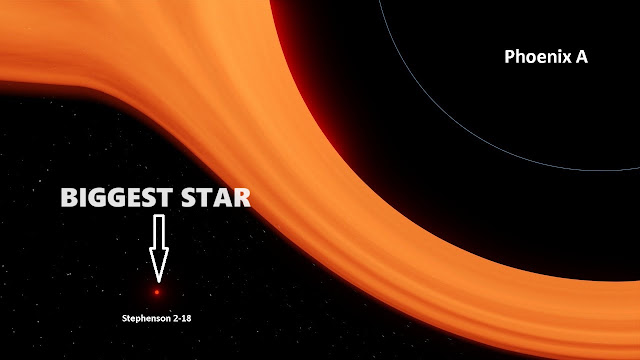Biggest Star vs Black Hole: Epic Size Comparison!
The universe is home to some of the most mind-boggling extremes, and none are more striking than comparing the biggest star ever discovered to a supermassive black hole. The colossal sizes of these celestial giants stretch the imagination and offer a profound sense of our cosmos' scale.
The Biggest Star: UY Scuti
Facts About UY Scuti
- Type: Red supergiant, nearing the end of its life.
- Size: Approximately 1,700 times the Sun’s radius. If placed at the center of our solar system, its outer layers would engulf the orbit of Jupiter.
- Mass: Around 30 times the mass of the Sun, but its low density gives it its enormous size.
Volume Comparison
UY Scuti’s volume is so vast that it could fit over 5 billion Suns inside it! Despite its size, red supergiants like UY Scuti are tenuous, with extended atmospheres composed of diffuse gas.
The Black Hole: TON 618
Facts About TON 618
- Type: Supermassive black hole, one of the largest ever observed.
- Mass: Estimated at 66 billion solar masses.
- Event Horizon: Its Schwarzschild radius (the size of the "shadow" or event horizon) spans approximately 1,300 AU, equivalent to 19 times the distance between the Sun and Pluto.
Volume Comparison
While black holes themselves have no physical volume due to their singularity, the event horizon represents the "size" of the black hole. TON 618's event horizon dwarfs UY Scuti, encompassing a region so large that it could fit over 40,000 solar systems inside.
Comparing Their Scales
| Feature | UY Scuti | TON 618 |
|---|---|---|
| Type | Red supergiant star | Supermassive black hole |
| Mass | ~30 solar masses | 66 billion solar masses |
| Size | ~1,700 solar radii | ~1,300 AU (event horizon) |
| Volume (Relative) | Could fit 5 billion Suns | Could enclose 40,000 solar systems |
| Location | Milky Way | ~10.4 billion light-years away |
Epic Insights
1. Density Contrast
- UY Scuti: Despite its massive size, it is extremely diffuse, with its outer layers composed of thin gas.
- TON 618: Infinitely dense, as all its mass is concentrated in a singularity at the center of its event horizon.
2. Lifespan
- UY Scuti: Red supergiants are short-lived in cosmic terms, burning out their fuel in a few million years before collapsing into a supernova, possibly forming a black hole.
- TON 618: Black holes can persist for billions of years, slowly accreting mass and growing larger over time.
3. Impact on Surroundings
- UY Scuti: Its size and luminosity affect nearby regions, shedding stellar material and creating stellar winds that enrich the interstellar medium.
- TON 618: Its immense gravitational pull dominates its galactic center, consuming gas, stars, and even light itself, while emitting energy in the form of quasars.
What If They Met?
If UY Scuti came near TON 618, the star would be effortlessly devoured by the black hole. As UY Scuti approached the event horizon, intense tidal forces would rip it apart in a process known as spaghettification, with its material accreted into TON 618's growing mass.
Conclusion
The comparison between UY Scuti and TON 618 is a testament to the staggering diversity of cosmic objects. While UY Scuti is the largest star known, its scale pales in comparison to the behemoth black holes that rule galactic centers. Such comparisons highlight the awe-inspiring extremes of the universe, where the gargantuan and the incomprehensible coexist.
Hashtags
#UYScuti #TON618 #BiggestStar #SupermassiveBlackHole #SizeComparison #CosmicExtremes #Astrophysics #GalacticGiants
Keywords
UY Scuti, TON 618, biggest star, largest black hole, size comparison, supermassive black hole, red supergiant, event horizon, cosmic scale, spaghettification, astrophysics.

No comments:
Post a Comment